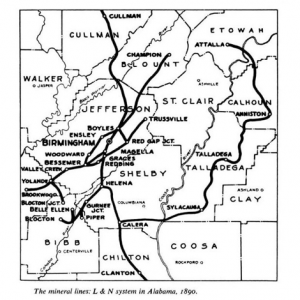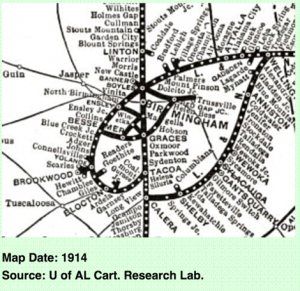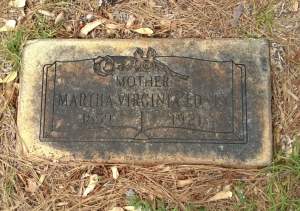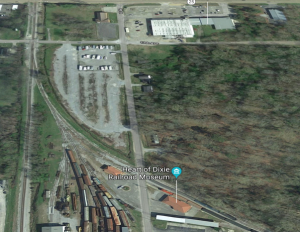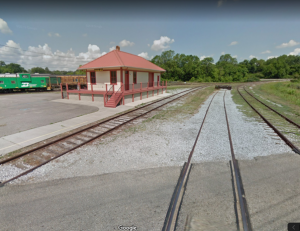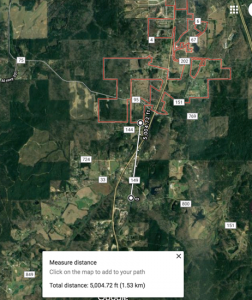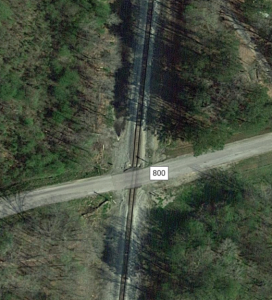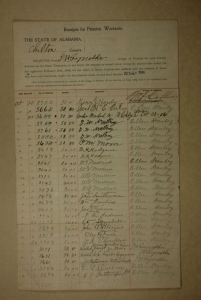About the Case
Date: July 28, 1893
County: Chilton
Victim(s): Ike Harper
Sex of Victim(s):male
Case Status: attempted
Ike Harper
July 28, 1893
South of Calera, Alabama
By the early 1890s, Calera was the railroad hub of Shelby County.[1] This prominence came, in part, from its intersection by the East Tennessee, Virginia, and Georgia (ETV&G) Railroad as well as the Louisville and Nashville (L&N) Railroad (See appendix A, Images 1 and 3.)[2] To capitalize on the transport of raw materials in Alabama, the L&N began construction of the Alabama Mineral Railroad around 1890 which passed through Calera on its way to drop off resources in Birmingham (See appendix A, Image 2.)[3] These railways intersected in Calera as depicted below.
The construction of this railway attracted a variety of workers to Calera such as H.M. Edney, a white section foreman, and Ike Harper, a black steel layer (See appendix B, Image 2.) In fact, Harper worked under Edney on his section of the railway and it was from this connection that the two apparently crossed paths.[4] At some point, Edney became dissatisfied with the quality of Harper’s work and fired him. After being fired, it is reported that Harper became vengeful and traveled to the Edney’s home on the night of July 27, 1893, around 11 o’clock.[5] Once there, Harper supposedly entered the home through an open window and made his way to a sleeping Mrs. Martha Edney (See appendix B, Image 1.) He then attempted to assault her at which point she cried out. This caused Mr. H.M. Edney to rush into the room, armed with a shotgun, and fire with no success at a fleeing Harper.[6] The next morning, bloodhounds were obtained from a Mr. Hand in Jemison, about 10 miles south of Calera, and a posse formed to pursue Harper.[7] During the pursuit, a black man named Jones, Jameson, or James was come upon and shot through the breast. It is reported that Jones was mistaken as Harper and was shot upon showing “fight.”[8] In all likelihood, this “fight” was Jones’s attempt to prevent his lynching by the hands of the mob. One account says Jones was seriously injured from this wound, but no other mention is made of him dying.[9] Once the posse figured out it had the wrong individual, it continued its pursuit of Harper. According to one breathless account, “Then followed an exciting chase of more than ten miles, the negro scared almost to death in desperation ran like a deer.”[10] After a chase, Harper was found lying in the road just outside of Montevallo, exhausted.[11] Though captured by Marshal C.F. Freeman, Harper was handed over to Sheriff P.M. Moore of Chilton County and transported on the ETV&G Railroad to Calera (See appendix F.)[12] Once in Calera, he was hauled to Mrs. Edney who identified him as her attacker.[13] In an attempt to supposedly prevent a lynching party from forming, Moore put Harper on a hand car for transport to Clanton’s jail on the L&N railway; however, they did not make it far (See hand car image appendix C.) About a mile south of Calera, the hand car was overtaken by a lynching mob.[14] Harper was taken and hanged to a nearby tree on July 28, 1893 (See appendix E.) The place he was hanged was clearly visible from the railroad.[15]
Unfortunately, there is little to no information regarding the personal lives of these black victims. As for Jones, he does not so much as receive a last name in any newspaper. It seems the papers and mob considered him a minor causality in the pursuit of justice. Similarly, there is little information on Harper outside of his lynching and work on the Alabama Mineral Railroad in Calera.[16] One must imagine this was grueling work, especially in the sweltering heat of Alabama’s summers. He quite possibly lived a meager life and drifted wherever work took him on the railway or otherwise. A question that comes to mind is how could so little be known about two humans murdered the same day? I believe the answer has to do with how whites viewed African Americans at this time as well as a twisted sense of justice. These views can be seen in the newspapers when Harper is called a “brute” and “fiend.” The killing of a brute was not something which required a thorough investigation. As well, the claim that Harper attempted to rape Mrs. Edney, whether true or not, compelled many white community members to seek what they thought was justice. By choosing to lynch Harper in sight of the railroad, one may infer the mob was proud of its actions and considered this a closed case with no further probing needed.
Much of what is known about the context of this case comes from white newspapers, railway maps, and images of a couple approximate locations that Harper traveled through. The newspapers lay out a narrative of what happened while pictures and maps provide specifics, showing the exact railways Harper traveled and worked on and a possible depot location at which he stopped. Knowing all of the details from a lynching that happened over a century ago is incredibly hard; however, we considered the most credible sources as those with the highest degree of overlap with other sources. For example, all of the newspapers reported Harper fleeing to Montevallo, being transported on the ETVG railway from Montevallo back to Calera, and subsequently getting lynched when headed to Clanton on the L&N railway. This information is corroborated by numerous maps from the time showing the ETV&G railway connecting Montevallo with Calera and the L&N railway joining Calera with Clanton. This information was also verified by a local historian’s description of a train depot that existed in Calera at the time and served both railways. As for the crime itself and chase of Harper, the most disseminated version of the story was taken as what most likely happened. The reason it is challenging to fully trust newspapers from this time period is the high degree of bias against African Americans contained in them. Many of the crimes these individuals were charged with were baseless and advanced someone else’s agenda, generally that of a white individual. For this reason, it is hard to judge the veracity and circumstances under which the crime was committed. Though much progress was made in this research concerning Ike Harper, little is known about the Jones, James, or Jameson individual who was shot in Harper’s pursuit. Though it is said he was shot fatally, there was no follow-up on his condition in any subsequent newspapers, as far as our research found. Though research into this mysterious victim may be fruitless, there exists the possibility that some source describes what happened to him after being shot.
It seems the lynchings of Ike Harper and Jones had little effect on the white residents of Calera. The killing of Harper was viewed as justice served and the demise of Jones as an unfortunate causality in this pursuit of justice. The Alabama Mineral Railroad on which Harper and Edney worked was completed around 1903 and Calera grew in prominence as a railroad hub in Alabama.[17] The lynchings of Ike Harper and Jones shed light on how the white community of Calera viewed its black neighbors. Jones was by all accounts an innocent bystander who was most likely shot while attempting to prevent his own lynching. The indifference shown to him in newspapers is startling and reflects how devalued the life of an African American was in this time. As well, the overt location Harper was hanged by the railroad tracks leaves us with two grim messages from the past. One, the perpetrators expected no consequence for taking another human’s life, and two, they wanted railroad travelers from across the nation to see how Calera dealt with its black community.
Appendix A: Maps
(1) Louisville and Nashville railway linking Calera and Clanton
(2) Alabama Mineral Railroad passing through Calera
(3) ETV&G Railroad linking Montevallo and Calera
Appendix B: Information on Edneys
(1) Thought to be grave marker of Martha Edney (individual Harper raped)
(2) Census record from 1900 showing the Edney family with a H.M. Edney as a “foreman”
Appendix C: Hand car
(1) Handcar similar to what Harper was put on
Appendix D: Approximate location of Calera Depot
(1) Approximate location of Calera train depot. L&N runs in a north-south direction and ETV&G runs in an east-west direction
Appendix E: Possible Lynching location of Ike Harper’s Lynching
(1) Aerial view of approximate location Harper was lynched
(2) Possible location Harper was lynched
Appendix F: P.M Moore background information
(1) Confederate pension fund for P.M. Moore
(2) P.M. Moore takes board of revenue
[1] Seales, Bobby Joe. Early History of Calera, http://www.algenweb.org/shelby/Calera.html. (map at bottom of the page shows intersection of Alabama Mineral, ETV&G, and L&N all in Calera.)
[2] JPEG of L&N crossing through Calera https://commons.wikimedia.org/wiki/File:1901_Poor%27s_Louisville_and_Nashville_Railroad.jpg; “East Tennessee, Virginia and Georgia Railway.” Wikipedia, Wikimedia Foundation, 1 Aug. 2019, https://en.wikipedia.org/wiki/East_Tennessee,_Virginia_and_Georgia_Railway.
[3] “Birmingham Mineral RR.” Historic Birmingham Mineral Railroad Signs Project, Mid-South Chapter of the Railway & Locomotive Historical Society, Inc, http://rlhs.org/Chapters/msc/bml.html.
[4] “He is Quietly Lynched: Lindsay Harper Pays the Penalty for His Crime.: A Hot Chase With Bloodhounds: Mrs. H. M. Dargged from Her Bed Out Through a Window-Her Timely Screams Arouse Her Husband.” The Weekly Advertiser (Montgomery, AL), Aug. 1, 1893; “A Negro Lynched: The Wife of a Railroad Section Foreman Choked and Badly Bruised.” The Daily Chronicle (Centralia, WA), July 29, 1893; “A Would-Be Rapist Hung.” The Eufaula Daily Times (Eufaula, AL), July 30, 1893; “Judge Lynch Presided.” The Shelby Sentinel (Calera, AL), Aug. 3, 1893.
[5] “Hanged Him To A Tree.: Whites and Blacks Lynch a Negro Brute At Calera, Alabama.” Wheeling Register (Wheeling, WV), July 31, 1893; “Slashed His Throat: Judge Lynch Presided.: Negro Confessed the Rape and the Mob Soon Disposed of Him.” The Memphis Commercial (Memphis, TN), July 29,1893; “An Alabama Lynching.” St. Louis Globe-Democrat (St. Louis, MO), July 29, 1893.
[6] “A Would-Be Rapist Hung.” The Eufaula Daily Times (Eufaula, AL), July 30, 1893; “Judge Lynch Presided.” The Shelby Sentinel (Calera, AL), Aug. 3, 1893; “He is Quietly Lynched: Lindsay Harper Pays the Penalty for His Crime.: A Hot Chase With Bloodhounds: Mrs. H. M. Dargged from Her Bed Out Through a Window-Her Timely Screams Arouse Her Husband,” Jacksonville Republican (Jacksonville, MS), Aug. 5, 1893.
[7] “A Would-Be Rapist Hung.” The Eufaula Daily Times (Eufaula, AL), July 30, 1893.
[8] “A Negro Lynched: The Wife of a Railroad Section Foreman Choked and Badly Bruised.” The Daily Chronicle (Centralia, WA), July 29, 1893; “A Would-Be Rapist Hung.” The Eufaula Daily Times (Eufaula, AL), July 30, 1893; “A Would-Be Rapist Hung.” The Times and News (Eufaula, AL), Aug. 3, 1893; “Hanged Him To A Tree.: Whites and Blacks Lynch a Negro Brute At Calera, Alabama.” Wheeling Register (Wheeling, WV), July 31, 1893; “A Negro Lynched and Another Shot.” The Times-Democrat (New Orleans, LA) July 29, 1893; “Slashed His Throat: Judge Lynch Presided.: Negro Confessed the Rape and the Mob Soon Disposed of Him.” The Memphis Commercial (Memphis, TN), July 29,1893; “An Alabama Lynching.” St. Louis Globe-Democrat (St. Louis, MO), July 29, 1893; “Crime’s Calender. The Day’s Record from the Dark Side of Life. Negro Fiend Who Deserved His Fate,” The Atlanta Constitution (Atlanta, GA), July 29, 1893.
[9] “A Would-Be Rapist Hung.” The Eufaula Daily Times (Eufaula, AL), July 30, 1893.
[10] “He is Quietly Lynched: Lindsay Harper Pays the Penalty for His Crime.: A Hot Chase With Bloodhounds: Mrs. H. M. Dragged from Her Bed Out Through a Window-Her Timely Screams Arouse Her Husband,” Jacksonville Republican (Jacksonville, MS), Aug. 5, 1893.
[11] “He is Quietly Lynched: Lindsay Harper Pays the Penalty for His Crime.: A Hot Chase With Bloodhounds: Mrs. H. M. Dragged from Her Bed Out Through a Window-Her Timely Screams Arouse Her Husband,” Jacksonville Republican (Jacksonville, MS), Aug. 5, 1893; “Local Brevities,” The Chilton View (Clanton, AL), Aug. 3, 1893.
[12] “A Would-Be Rapist Hung.” The Times and News (Eufaula, AL), Aug. 3, 1893; “A Would-Be Rapist Hung.” The Eufaula Daily Times (Eufaula, AL), July 30, 1893.
[13] The Union-Banner (Clanton, AL), Aug. 3, 1893; “He is Quietly Lynched: Lindsay Harper Pays the Penalty for His Crime.: A Hot Chase With Bloodhounds: Mrs. H. M. Dargged from Her Bed Out Through a Window-Her Timely Screams Arouse Her Husband,” Jacksonville Republican (Jacksonville, MS), Aug. 5, 1893; “A Would-Be Rapist Hung.” The Eufaula Daily Times (Eufaula, AL), July 30, 1893.
[14] The mob referenced in the newspapers below supposedly consisted of black and white individuals; however, this claim is dubious at best.
“Judge Lynch Presided.” The Shelby Sentinel (Calera, AL), Aug. 3, 1893. and “A Would-Be Rapist Hung.” The Times and News (Eufaula, AL), Aug. 3, 1893; “Met the Usual Fate.” The Bismarck Tribune (Bismarck, ND), July 30, 1893; “Slashed His Throat: Judge Lynch Presided.: Negro Confessed the Rape and the Mob Soon Disposed of Him.” The Memphis Commercial (Memphis, TN), July 29,1893; “An Alabama Lynching.” St. Louis Globe-Democrat (St. Louis, MO), July 29, 1893; “Hanged Him To A Tree.: Whites and Blacks Lynch a Negro Brute At Calera, Alabama.: His Crime a Fiendish One, Prompted By Spite – Murderers Executed.” Louisville Courier Journal (Louisville, KY), July 29, 1893; “He is Quietly Lynched: Lindsay Harper Pays the Penalty for His Crime.: A Hot Chase With Bloodhounds: Mrs. H. M. Dargged from Her Bed Out Through a Window-Her Timely Screams Arouse Her Husband.” The Weekly Advertiser (Montgomery, AL), Aug. 1, 1893; “Late News in Brief.” The Twice-A-Week Messenger (Owensboro, KY), Aug. 3, 1893.
[15] “Crime’s Calender. The Day’s Record from the Dark Side of Life. Negro Fiend Who Deserved His Fate,” The Atlanta Constitution (Atlanta, GA), July 29, 1893; “Judge Lynch Presided.” The Shelby Sentinel (Calera, AL), Aug. 3, 1893; “Hanged Him To A Tree.: Whites and Blacks Lynch a Negro Brute At Calera, Alabama.” Wheeling Register (Wheeling, WV), July 31, 1893.
[16] Seales, Bobby Joe. Early History of Calera, http://www.algenweb.org/shelby/Calera.html.; “List of Alabama Railroads.” Wikipedia, Wikimedia Foundation, 20 Sept. 2019, https://en.wikipedia.org/wiki/List_of_Alabama_railroads.
[17] “List of Alabama Railroads.” Wikipedia, Wikimedia Foundation, 20 Sept. 2019, https://en.wikipedia.org/wiki/List_of_Alabama_railroads.

